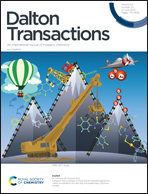High radiative efficiency based on intramolecular charge transfer in a 9,9′-bianthracene-ortho-carboranyl luminophore†
Abstract
Herein, we prepared an o-carborane compound (9biAT) linked to a 9,9′-bianthracene moiety at each C9-position. The compound exhibited reddish emission in solid and solution states. The solvatochromism effect and theoretical calculation results for the excited (S1) state of 9biAT verified that the emission was attributed to ICT transition. In particular, the structural rigidity and the orthogonal geometry around the carborane enhanced ICT-based emission in the solution state at 298 K, resulting in a considerably high quantum efficiency (Φem = 86%) in cyclohexane. In addition, both the Φem value and radiative decay constant (kr) gradually decreased with an increase in the polarity of the organic solvent. Theoretical modelling of the charge distribution in the S1-optimised geometry revealed that charge recombination in the radiative-relaxation process upon ICT transition could be delayed under polar conditions. Consequently, a high Φem value in the solution state at room temperature can be obtained by maintaining molecular rigidity and controlling the polarity of the environment.



 Please wait while we load your content...
Please wait while we load your content...